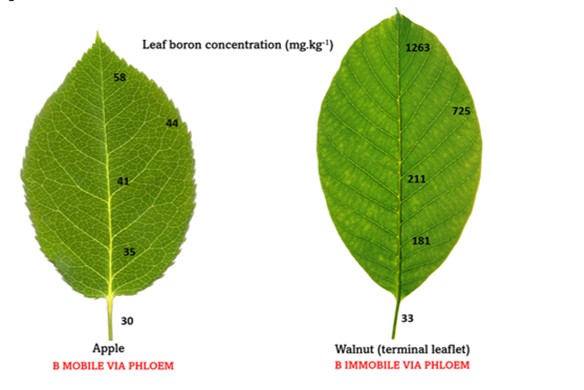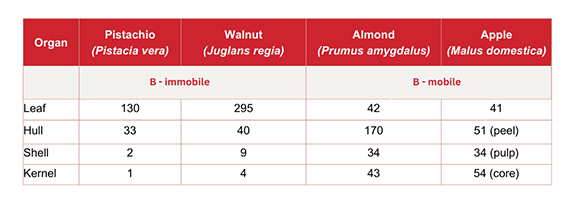Boron (B) deficiency is directly affected by boron mobility or immobility in plants. In those species in which boron is immobile in the phloem, foliar-applied boron will not be translocated from the site of application. This means there is not enough boron to adequately supply the plant cells that are required for tissue formation. In those species where boron is immobile via phloem, boron must be applied via soil.
Boron mobility research
The work of Brown and Shelp (1997) provides plenty of information related to boron mobility in various plant species. They have demonstrated that the phloem mobility of boron varies significantly among plant species. These results show that boron is mobile in all plant species that use simple sugars—known as polyols—as primary compounds in photosynthetic processes (eg apple trees). Boron forms a complex with these polyols and is transported in the phloem tissues to active growing regions in the plant. In those plant species which do not produce significant quantities of polyols (eg walnut trees), boron cannot re-enter the phloem stream after it has been delivered to leaf tissues in the transpiration stream (xylem tissue). This boron will tend to accumulate in the leaves and boron is said to be immobile in these species.
Figure 1

Source: Adapted from Brown, P and Shelp, B. (1997). Boron mobility in plants. Plant and Soil. 193. 10.1023/A:1004211925160
Evidence of phloem mobility or immobility can also be found by studying the distribution of boron within different tissues of a given species. For example, in field conditions, pistachio and walnut contained the highest boron concentrations in the leaves, and the lowest boron concentrations in the fruit and seed. This indicates that the boron from leaves does not translocate to fruit and seeds. In contrast, almond and apple trees grown in the same field had the highest boron concentrations in the hulls and fruit, respectively, with much lower boron in the leaves.
Table 1: Boron distribution (mg B.kg-1 dry wt) in leaf and fruit organs of four trees

Source: Adapted from Brown, P and Shelp, B. (1997). Boron mobility in plants. Plant and Soil. 193. 10.1023/A:1004211925160.
Boron mobility in certain crops
The concentrations of boron on leaves of different ages on the same plant also provides evidence of boron mobility in a species. Higher boron concentrations in basal (older) than apical (younger) leaves indicates boron immobility in the phloem. In contrast, higher boron concentrations in younger leaves indicates boron immobility in the phloem, since younger leaves have transpired less water than the older leaves.
Table 2: Leaf boron concentration (ppm dry wt) along a shoot in various plant species

Source: Adapted from Brown, P and Shelp, B. (1997). Boron mobility in plants. Plant and Soil. 193. 10.1023/A:1004211925160
For more information about boron how boron mobility can affect your crops, contact your local U.S. Borax agriculture expert.
Resources